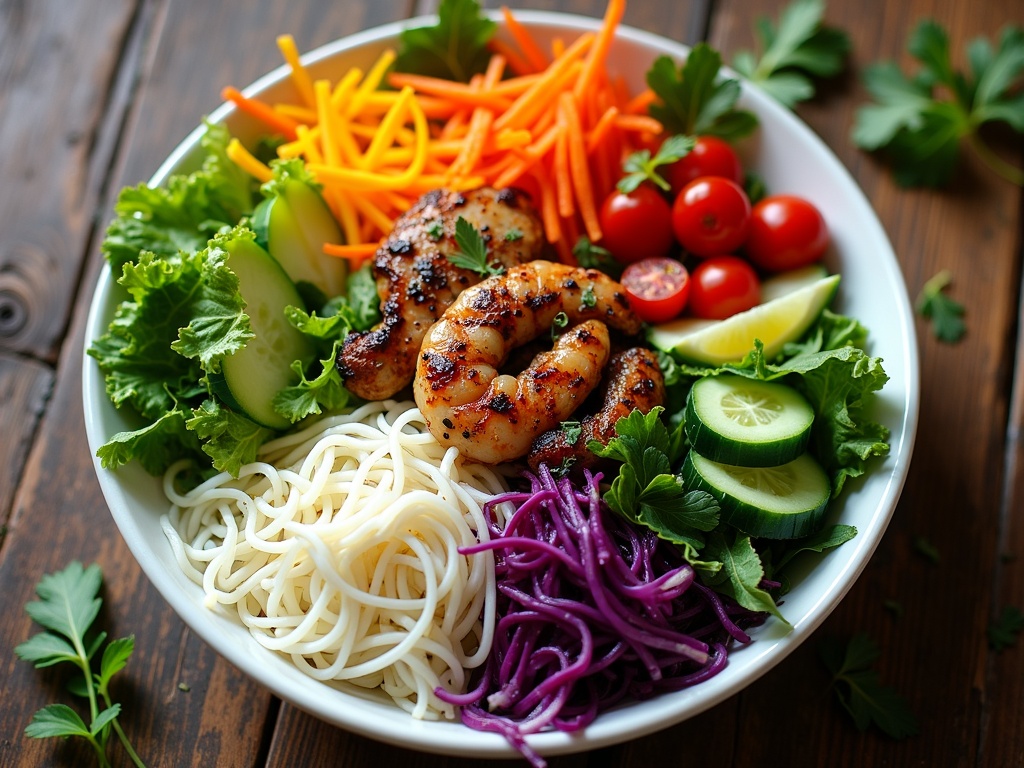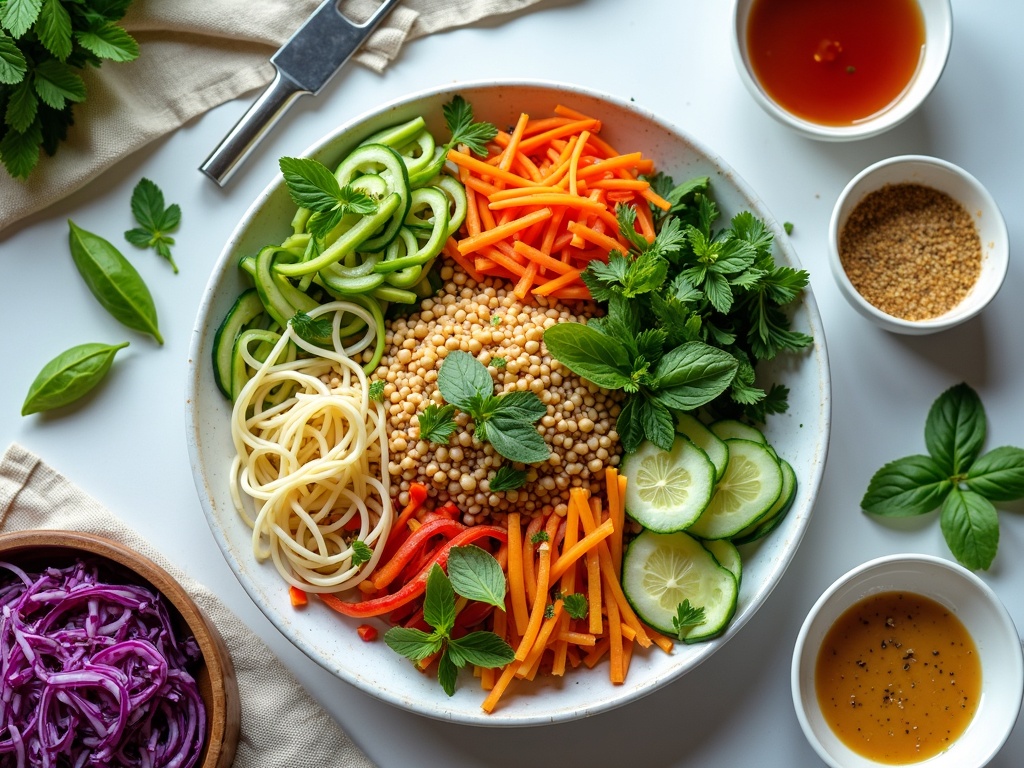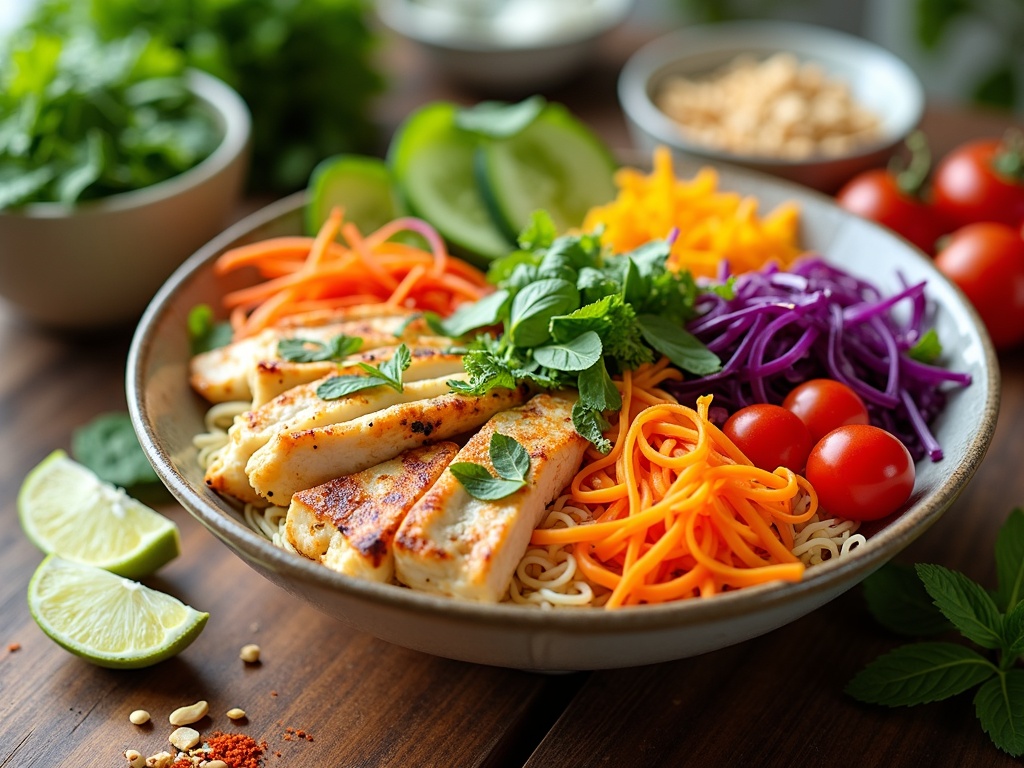Rice vermicelli creates an outstanding base for building nutritious, balanced meals that merge quick preparation convenience with remarkable health advantages. This naturally gluten-free noodle crafted from rice flour and water delivers moderate glycemic impact while providing a flexible foundation for adding lean proteins, vibrant vegetables, and aromatic herbs into satisfying bowl meals.
Key Takeaways
- Follow the healthy plate model by filling half your bowl with non-starchy vegetables, one-quarter with lean protein (20–30g), and one-quarter with rice vermicelli for optimal nutrition balance.
- Choose lean cooking methods like grilling, baking, or air-frying for proteins such as chicken breast, shrimp, tofu, or lean pork to maximize nutrition while minimizing excess calories and unhealthy fats.
- Add colorful vegetables including carrots, cucumber, bell peppers, and leafy greens to achieve 5–8 grams of fiber per serving while providing diverse phytonutrients and antioxidants.
- Use fresh herbs generously such as mint, cilantro, and Thai basil to enhance flavor profiles and boost antioxidant content without adding calories.
- Select light, flavorful dressings under 50 calories per serving like Vietnamese nuoc cham, light peanut-lime sauce, or ginger-soy vinaigrette to tie flavors together without overwhelming the fresh ingredients.
What is Rice Vermicelli? A Healthy Foundation for Quick, Nutritious Meals
I’ve discovered that rice vermicelli serves as one of the most versatile and accessible ingredients for creating quick, healthy meals at home. This thin noodle is made from a simple paste containing only rice flour and water, resulting in a naturally gluten-free product that opens up countless culinary possibilities.
Nutritional Profile and Health Benefits
Rice vermicelli delivers impressive nutritional value while maintaining its light, digestible nature. A standard 1 cup serving of cooked rice vermicelli (approximately 176g) contains roughly:
- 190-200 calories
- 42-45g of carbohydrates
- Less than 1g of fat
- Only 1.5-2g of protein
This makes it an excellent choice for those monitoring their caloric intake while still needing substantial energy from carbohydrates.
The glycemic index (GI) of rice vermicelli ranges from 53-61, positioning it as a moderate option that’s lower than white bread but higher than whole grains. This moderate GI means your blood sugar levels won’t spike as dramatically compared to other refined carbohydrates, making it a reasonable choice for balanced meal planning.
For individuals dealing with celiac disease or gluten sensitivity, rice vermicelli becomes an excellent alternative to wheat-based pastas. I’ve found that many people appreciate having this option available, especially when preparing family meals that accommodate various dietary restrictions.
Culinary Versatility and Global Applications
Rice vermicelli’s light, neutral flavor profile allows it to effectively absorb other ingredients, making it a perfect canvas for diverse flavor combinations. This characteristic makes it incredibly versatile for both simple weeknight dinners and more elaborate weekend cooking projects.
In Southeast Asian cuisines, particularly Vietnamese cuisine where it’s called ‘bún’, rice vermicelli forms the foundation for numerous beloved dishes. You’ll find it in fresh spring rolls, hearty noodle soups, and refreshing salad bowls. The Vietnamese have mastered the art of pairing rice vermicelli with grilled meats, creating dishes like rice vermicelli with grilled pork that showcase the noodle’s ability to complement bold flavors.
I particularly appreciate how rice vermicelli adapts to different cooking methods. You can serve it cold in summer salads, warm in comforting soups, or at room temperature in spring rolls. This flexibility makes it an ideal ingredient for meal prep, as it maintains its texture well across various preparations.
The cooking process itself couldn’t be simpler. Most rice vermicelli varieties require only a brief soak in hot water rather than traditional boiling, making them perfect for quick meal assembly. This convenience factor, combined with their long shelf life when stored properly, makes rice vermicelli an excellent pantry staple for busy households.
Rice vermicelli’s ability to pair with vegetables, proteins, herbs, and sauces from various culinary traditions means you’re never limited to one type of cuisine. Whether you’re craving Asian-inspired flavors, Mediterranean combinations, or fusion creations, rice vermicelli provides the perfect neutral base that won’t compete with your chosen flavors.
For a visual guide on using rice vermicelli in delicious meals, check out the video below:
https://www.youtube.com/watch?v=3dsYP-bvI3c
Build a Better Bowl: The Perfect Vermicelli Meal Formula
I’ve discovered that creating the perfect vermicelli bowl follows a simple yet effective formula based on the Healthy Plate model. This approach transforms rice vermicelli from a basic side dish into a complete, nutritionally balanced meal that satisfies both your taste buds and your body’s nutritional needs.
Master the Bowl Structure
Start by filling half your bowl with non-starchy vegetables, dedicating one-quarter to lean protein, and reserving the remaining quarter for rice vermicelli. This ratio ensures you’re getting maximum nutrition while controlling carbohydrate portions. I recommend aiming for 20-30 grams of protein per serving to support satiety and muscle health. Whether you choose grilled chicken, tofu, shrimp, or grilled pork, this protein foundation keeps you satisfied for hours.
Add at least 2 cups of mixed vegetables to achieve 5-8 grams of dietary fiber, helping you reach the recommended 25-30 grams daily. Fresh cucumber, crisp lettuce, shredded carrots, and herbs like cilantro and mint create the perfect base for your vermicelli creation.
Embrace the Rainbow Philosophy
Each color in your vegetable selection delivers unique phytonutrients that boost both nutrition and visual appeal. Orange foods like carrots provide beta-carotene for eye health, while green vegetables offer chlorophyll and Vitamin K for bone strength. Red bell peppers contribute lycopene, a powerful antioxidant that supports heart health.
I suggest incorporating these colorful additions into your bowl:
- Purple cabbage for anthocyanins and crunch
- Yellow bell peppers for vitamin C and sweetness
- Dark leafy greens for iron and folate
- Cherry tomatoes for lycopene and acidity
- Fresh herbs for flavor and antioxidants
This colorful approach doesn’t just look Instagram-worthy – it ensures you’re getting a diverse range of nutrients that work together to support optimal health.
Finish your bowl with a light dressing that enhances flavors without overwhelming the fresh ingredients. I always choose dressings under 50 calories and 200mg of sodium per 2-tablespoon serving. A simple lime and fish sauce dressing or a light peanut sauce works perfectly. These light touches allow the natural flavors of your vegetables and protein to shine while adding just enough richness to tie everything together.
Consider experimenting with different rice vermicelli preparations or even incorporating the noodles into fresh spring rolls for variety. This formula adapts easily to any cuisine style while maintaining its nutritional integrity.

Protein Power: Lean Options for Hearty Vermicelli Bowls
I recommend choosing healthy cooking methods that maximize nutrition while delivering exceptional flavor. Grilling, baking, poaching, steaming, and air-frying create delicious proteins without the excess calories and unhealthy fats that come with deep or pan frying.
Animal Protein Champions
Grilled chicken breast stands out as a nutritional powerhouse, delivering 31g of protein and just 165 calories per 4oz serving. Poached or grilled shrimp offers another excellent choice with 24g of protein and only 99 calories per 4oz. I often pair these proteins with Vietnamese rice vermicelli for authentic flavor combinations.
Grilled lean pork tenderloin provides a satisfying option at 140 calories and 4.5g fat per 4oz — a dramatically healthier alternative to fried pork belly, which contains over 500 calories and 50g fat in the same portion. Flaked white fish varieties like tilapia, cod, or halibut contribute lean protein that complements vermicelli’s delicate texture perfectly.
Plant-Based Protein Alternatives
Plant-based proteins deserve equal consideration in your vermicelli bowls.
- Baked or air-fried firm tofu delivers 9g of protein and 88 calories per 4oz.
- Edamame adds protein and a satisfying bite.
- Pan-seared tempeh introduces deep umami notes.
- Roasted chickpeas offer crunch and plant-based protein.
These options work particularly well in family meal preparations where dietary preferences vary.
Techniques for Maximum Flavor
Flavor enhancement begins with smart marination techniques. I marinate chicken in lemongrass, garlic, and lime juice for authentic Vietnamese taste that pairs beautifully with rice vermicelli. This combination creates the foundation for dishes that rival restaurant quality at home.
Tofu preparation requires special attention for optimal results. I press tofu before cooking to remove excess water, which allows it to achieve a satisfying crisp texture when air-fried or baked. This technique transforms bland tofu into a protein that actually enhances your vermicelli bowl rather than merely filling space.
Satisfying and Nutritious Bowls
Smart protein selection makes the difference between a heavy, calorie-laden meal and a nutritious bowl that energizes rather than weighs you down. These lean options provide the building blocks your body needs while keeping calories in check. Whether you’re preparing spring roll recipes or complete vermicelli bowls, these protein choices ensure your meals deliver both satisfaction and nutrition.
Colorful Complements: Vegetables, Herbs and Healthy Dressings
I’ve discovered that transforming rice vermicelli into a complete meal starts with building a foundation of crisp vegetables and aromatic herbs. Shredded carrots bring natural sweetness while delivering over 50% of your daily Vitamin A requirement. Cucumber ribbons add refreshing crunch, and bean sprouts contribute a satisfying bite. I always include sliced bell peppers for their vibrant color and vitamin C content, while shredded romaine lettuce and purple cabbage create textural contrast that makes each forkful interesting.
Fresh herbs elevate your dish from simple to spectacular. Mint provides cooling freshness that balances rich flavors, while cilantro adds a bright citrusy zing that awakens the palate. Thai basil brings an anise-like spice profile that’s particularly wonderful in Vietnamese-inspired preparations. I recommend using generous handfuls rather than modest sprinkles—this approach not only intensifies flavor but also significantly boosts antioxidant content.
Essential Sauce Combinations
Your sauce determines the character of your rice vermicelli dish. These three options always impress:
Classic Vietnamese Nuoc Cham blends lime juice, water, fish sauce or soy sauce, sweetener, garlic, and chili—balancing sweet, sour, salty, and spicy notes.
A light peanut-lime sauce made from powdered peanut butter has just 35–45 calories and 2–3 grams of sugar, offering rich flavor with less guilt.
Ginger-soy vinaigrette delivers bold taste with just 150mg of sodium—far less than store-bought teriyaki sauces.
To elevate your vermicelli bowls, prep veggies with precision. A julienne peeler makes perfect carrot matchsticks; a spiralizer turns cucumbers into silky ribbons. This ensures every bite blends noodles and veggies beautifully.
Add at least two cups of mixed vegetables for volume, crunch, and under 100 calories. Purple cabbage brings antioxidants. Romaine contributes folate and vitamin K. Bell peppers offer a vitamin C boost.
Timing matters too. Delicate herbs like mint or cilantro should be added last to stay fresh. Heartier vegetables, like carrots and cabbage, actually improve with a short marination in sauce.
Temperature contrast also enhances the dish. Cool veggies layered over warm vermicelli create an engaging bite. This balance works well with grilled proteins like Vietnamese pork or tofu.
Rotate veggies by season—use cucumbers and fresh herbs in summer, or shredded Brussels sprouts and radishes in winter. Prep components in advance and assemble just before serving for optimal texture and color.
Proper knife skills improve presentation and texture. Keep cuts even and consistent—thin matchsticks work best alongside the noodles for a clean, balanced finish.

Sources:
What is Rice Vermicelli? A Healthy Foundation for Quick, Nutritious Meals
Build a Better Bowl: The Perfect Vermicelli Meal Formula
Protein Power: Lean Options for Hearty Vermicelli Bowls
Colorful Complements: Vegetables, Herbs and Healthy Dressings


